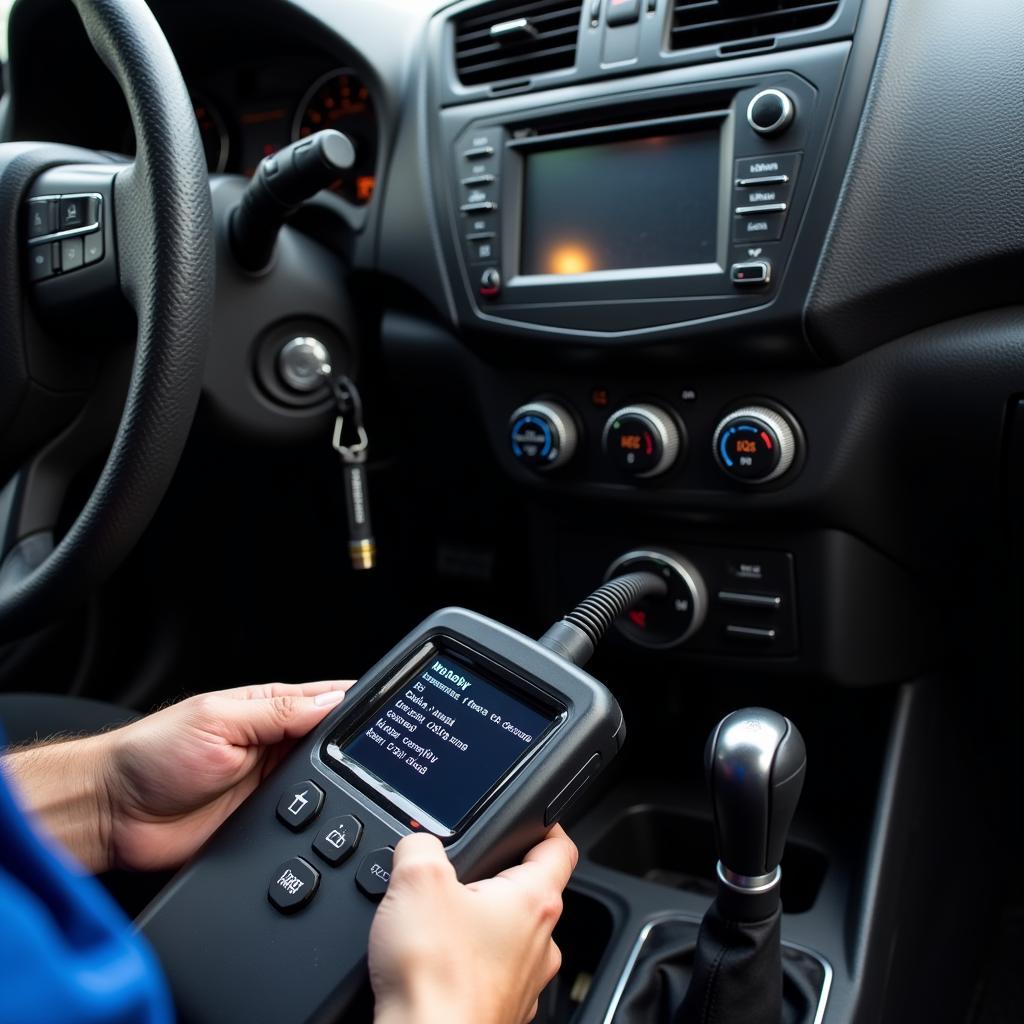A “Collision Warning System with Active Brake Application FCW-Stop” message appearing on your dashboard can be alarming. This system, designed to enhance safety by preventing or mitigating collisions, uses sensors to monitor the distance between your vehicle and the one in front of you. This article delves into the intricacies of this system, potential causes for the alert, and steps you can take to address it.
How the Collision Warning System with Active Brake Application FCW-Stop Works
The system uses a combination of radar, lidar, or cameras strategically positioned on the vehicle to constantly scan the road ahead. When the system detects an obstacle or a vehicle in your path and determines a potential collision is imminent, it triggers a series of warnings and interventions:
- Visual Warning: A flashing light or icon, often red, appears on the dashboard or heads-up display, alerting the driver to the potential hazard.
- Audible Warning: A beeping sound or voice alert may accompany the visual warning, demanding the driver’s immediate attention.
- Braking Assistance: If the driver brakes but insufficient force is applied, the system automatically increases braking pressure to help avoid or lessen the impact.
- Autonomous Emergency Braking (AEB): In critical situations where the driver fails to react, the system can independently apply the brakes to either prevent the collision or significantly reduce the severity.
Common Causes for “Collision Warning System with Active Brake Application FCW-Stop” Malfunctions
While designed for safety, the system is not without its vulnerabilities. Here are some common culprits behind malfunctions:
- Sensor Obstructions: Dirt, debris, snow, or ice covering the sensors can hinder their ability to accurately detect objects, triggering false alarms or system deactivation.
- Adverse Weather Conditions: Heavy rain, fog, or snow can interfere with the sensor signals, leading to system errors.
- Electrical Issues: Faulty wiring, a blown fuse, or a malfunctioning control module can disrupt the system’s operation.
- Software Glitches: Like any software-dependent system, bugs or glitches can arise, requiring software updates or recalibration.
- Component Failure: Damage to the sensors, cameras, or braking system components due to an accident or wear and tear can lead to system failure.
Troubleshooting Steps for “Collision Warning System with Active Brake Application FCW-Stop” Issues
When faced with a “Collision Warning System with Active Brake Application FCW-Stop” message, here are some troubleshooting steps:
- Check for Obstructions: Visually inspect all sensors and cameras for any dirt, debris, or obstructions. Gently clean them using a soft cloth and appropriate cleaning solution.
- Restart the Vehicle: Sometimes, a simple system reboot can resolve temporary glitches. Turn off the engine, wait a few minutes, and then restart the vehicle.
- Consult the Owner’s Manual: Your owner’s manual provides specific information about your vehicle’s safety systems, including troubleshooting tips.
- Check the Battery: A weak or dying battery can cause various electrical system malfunctions, including issues with the collision warning system. Ensure your battery is in good condition.
 Mechanic using a diagnostic tool on a car
Mechanic using a diagnostic tool on a car
- Seek Professional Diagnosis: If the issue persists, it’s crucial to have your vehicle inspected by a qualified mechanic specializing in automotive electronics and safety systems. They possess the expertise and specialized diagnostic equipment to pinpoint and rectify the problem.
The Importance of Timely Resolution
“The collision warning system with active brake application is a critical safety feature that can be lifesaving in emergency situations,” says automotive electronics expert, Dr. Emily Carter. “Ignoring warning messages or delaying repairs could increase the risk of accidents.”
FAQs about Collision Warning System with Active Brake Application FCW-Stop
Q: Can I temporarily disable the system?
A: While some vehicles may allow you to adjust the system’s sensitivity or temporarily disable certain features, it’s generally not recommended to completely deactivate a safety system designed to protect you.
Q: Will the system activate every time I brake hard?
A: No, the system is designed to activate only when it detects an imminent collision risk. Hard braking alone won’t necessarily trigger the system if there’s sufficient distance between you and the obstacle.
Q: Does the system require regular maintenance?
A: While there’s no scheduled maintenance for the system itself, regular vehicle checkups should include an inspection of the sensors, cameras, and related components for any signs of damage or malfunction.
collision warning system with fcw-stop active brake application
Q: Can aftermarket installations interfere with the system?
A: Yes, modifications or installations that affect the vehicle’s electrical system, sensors, or braking system, especially those not performed by qualified professionals, can potentially interfere with the collision warning system’s operation.
258 collision warning system with fcw-stop active brake application
Conclusion
The “Collision Warning System with Active Brake Application FCW-Stop” is a crucial safety feature in modern vehicles. Understanding how it works, recognizing potential issues, and addressing them promptly can significantly enhance your safety and that of your passengers. Remember, prioritizing preventative measures and timely professional assistance is always recommended when it comes to sophisticated vehicle safety systems.

